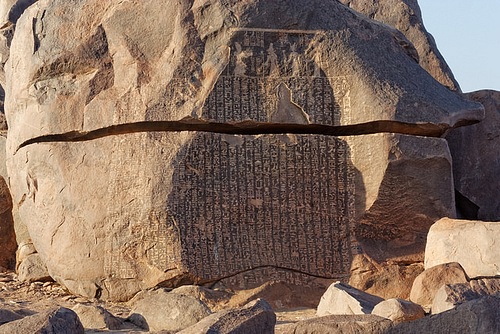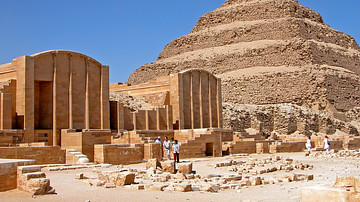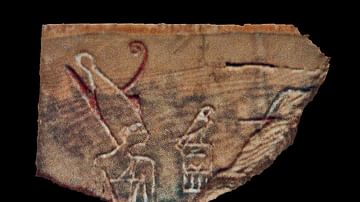
Djoser (also known as Netjerikhet, Tosorthos, and Sesorthos, c. 2670 BCE) was the first king of the Third Dynasty of Egypt, reigning for over twenty years. Some sources indicate a king named Sanakht as the first ruler of the Third Dynasty but this claim is challenged as Sanakht's name is only known from two reliefs, the Abydos king list, and the Turin papyrus, not from archaeological evidence. Early archaeologists identified Sanakht's tomb as mastaba K2 at Beit Khallaf based on the two reliefs mentioned above, which were found there; but this identification has been challenged and largely discredited. Manetho's chronology, routinely used to date the reigns of the kings of Egypt, is also unclear on who he was or when he ruled. Djoser's reign, following Khasekhemwy, is far more certain than the vague suggestions of a king named Sanakht and so he is now accepted as the first king of the Third Dynasty. Djoser is best known for his Step Pyramid, the first pyramid built in Egypt, although he initiated many other building projects; so many, in fact, that scholars have suggested a reign of almost thirty years to account for the number of tombs, temples, and monuments he commissioned.
Reign
Very little is known of Djoser's youth or family life. His name Netjerikhet means "divine of body" and 'Djoser' is derived from the Djed symbol of stability. He succeeded his father, Khasekhemwy, the last king of the Second Dynasty, and his mother was the queen Nimaathap. His wife was Hetephernebti who was probably his half-sister. Although it was common for the pharaoh to have a queen and lesser wives, Djoser took no other women besides Hetephernebti.
Once he assumed the throne, he almost instantly began commissioning his building projects. Historian Margaret Bunson writes that Djoser "ruled during an age witnessing advances in civilization on the Nile such as the construction of architectural monuments, agricultural developments, trade, and the rise of the cities" (66). Although cities had begun to grow during the First Dynasty, under Djoser's reign they became more numerous and the architecture more ornate. Djoser's pyramid complex alone is the best example of the great advance in architectural design at the beginning of the Third Dynasty. Ornamentation was taken to a much higher level and symbols used to remind people of the blessings of the gods and the harmony of the land. The Djed symbol which, besides representing stability, is associated with the god Osiris, was used in the pillars in Temple T of Djoser's Saqqara complex and appears on his other monuments as well.
The stability of the country under Djoser was due in part to his success in securing his borders and then extending them. Expansion of the realm into the region of Sinai was accomplished through military expeditions. He defeated the Libyans in battle and annexed part of their lands. The position of the king was linked to military ability and victories were a sign of the gods' favor. The armies of Djoser, therefore, brought honor to his name and to the country but he became legendary, without these campaigns and long before his Step Pyramid was built, for another reason: the re-building of the Temple of Khnum which ended a famine.
The Famine Stele
The Famine Stele is an inscription from the Ptolemaic Dynasty (332-30 BCE), long after Djoser's rule, which tells the story of how the king saved his country. A famine broke out in Egypt which lasted for seven years. No one knew how to resolve the problem and none of Djoser's consultants seemed to be of any use. Djoser had a dream in which the god Khnum, the god of the source of the Nile River, came to him and complained that his temple on the island of Elephantine (near modern-day Aswan) was in disrepair and people had lost their respect for the god who gave them life through the river.
Djoser consulted with his vizier Imhotep and with one of his governors, Medir, and they suggested he sail to the island of Elephantine to pay his respects to Khnum and see about the temple. Djoser did so and, finding the temple in the poor condition his dream had foretold, erected a new one in its place. Once the new temple was completed, the famine ended and Djoser was hailed as the hero of his people.
The temple built by Djoser, and the surrounding courtyard and outer buildings, may still be seen in the modern day, although the temple went through renovations during later dynasties. These modern-day ruins date from Djoser's reign and so the Famine Stele has been accepted by some as history and interpreted by others as legend. As the stone dates from almost 2,000 years after Djoser's reign, the actual significance of the inscription lies in how Djoser was remembered by his people; whether the event actually happened as described is immaterial. An unpopular pharaoh would not have generated such a legend, no matter what miraculous feats he was involved in, and the Famine Stele attests to the honor and high esteem Djoser was regarded with.
The Step Pyramid
This great respect he commanded is most notably expressed in his famous Step Pyramid at Saqqara which, like all the pyramids and monuments of Egypt, was built by skilled Egyptian craftsmen and laborers, not by slaves. Originally intended as a simple mastaba tomb, the Step Pyramid grew under the guidance and design of Imhotep to become the tallest structure of its time and a tourist attraction which drew people from all parts of the land. Professor and Egyptologist Miroslav Verner writes:
Few monuments hold a place in human history as significant as that of the Step Pyramid in Saqqara. Together with the structures that surround it, the pyramid composes Djoser's tomb complex. It can be said without exaggeration that his pyramid complex constitutes a milestone in the evolution of monumental stone architecture in Egypt and in the world as a whole. Here limestone was first used on a large scale as a construction material, and here the idea of a monumental royal tomb in the form of a pyramid was first realized (108-109).
The Step Pyramid is an architectural marvel which had never been attempted before in Egypt. Prior to this, kings were buried in mastabas, rectangular tombs built above underground chambers, rising at most 20 feet (6 meters) high. The Step Pyramid is a series of mastabas stacked on top of each other, each level a little smaller than the one beneath, to form the shape of a pyramid. Earlier mastabas were constructed of clay brick but the Step Pyramid was made of limestone blocks on which were carved images of trees (sacred to the gods of Egypt) and reeds, possibly symbolizing The Field of Reeds, the Egyptian afterlife.
The Pyramid Complex & Use of Stone
Historian Mar Van de Mieroop writes, "Earlier complexes at Abydos and at Saqqara near Memphis had been massive but they were of mud brick. A few elements only were of stone. Djoser's Step Pyramid complex at Saqqara was the earliest construction of its size in world history fully made of stone." (56) Building in stone seems to have been the idea of Imhotep whose inscription appears on the Step Pyramid as chief architect. Imhotep designed the pyramid under Djoser's reign, however, and so credit for working in stone was divided between him and his king. Moroslav Verner notes how later Egyptians referred to Djoser as the "opener of stone", meaning he was the first to use stone as a building material.

The pyramid complex was designed to be stunning and inspire awe. When completed, the Step Pyramid rose 204 feet (62 meters) high and was the tallest structure of its time. The surrounding complex included a temple, courtyards, shrines, and living quarters for the priests covering an area of 40 acres (16 hectares) and surrounded by a wall 30 feet (10.5 meters) high. Van de Mieroop writes:
Imhotep reproduced in stone what had been previously built of other materials. The facade of the enclosure wall had the same niches as the tombs of mud brick, the columns resembled bundles of reed and papyrus, and stone cyliners at the lintels of doorways represented rolled-up reed screens. Much experimentation was involved, which is especially clear in the construction of the pyramid in the center of the complex. It had several plans with mastaba forms before it became the first Step Pyramid in history, piling six mastaba-like levels on top of one another...The weight of the enormous mass was a challenge to the builders, who placed the stones at an inward incline in order to prevent the monument breaking up (56).
The actual chambers of the tomb were dug beneath the base as a maze of tunnels with rooms off the corridors to discourage robbers and protect the body and grave goods of the king. Djoser's burial chamber was carved of granite and, to reach it, one had to navigate the corridors which were filled with thousands of stone vessels inscribed with the names of earlier kings. The other chambers in the subterranean complex were for ceremonial purposes; but not for the living, only for the soul of the pharaoh.
Home of the Soul & Enduring Monument
The soul was thought to consist of nine aspects and one of them, the ba (the bird-shaped image often found on tomb engravings), was able to fly from earth to the heavens at will. It required some recognizable landmark on earth, however, and this would have been the pyramid. Once the ba, high above, saw the home of its owner, it could swoop down, enter, and visit the earthly plane again. The importance of names and images of pharaohs comes into play here in that the soul needed to be able to recognize its former home (physical body) on earth in order to be at rest in the afterlife. The statue of Djoser, erected at the complex, is the oldest known life-sized Egyptian statuary extant and would have been created for this purpose as well as to remind the living of the legacy of the great king.
Unfortunately, all of the precautions and intricate design of the underground complex did not prevent ancient robbers from finding a way in. Djoser's grave goods, and even his mummy, were stolen at some point in the past and all archaeologists found of the king was parts of his mummified foot and a few valuables overlooked by the thieves. His Step Pyramid and the surrounding buildings of the complex still remain, however, as testimony to the great king and hero of his people.
The pyramids, like any great works of art, continue to fascinate because they leave themselves open to interpretation by people of any culture and any time period. These interpretations, as with any painting or piece of literature, need to be based on the 'text' itself and, in this case, that text is the stone monuments themselves and the inscriptions and symbols found associated with them. However people have decided to interpret the pyramids in recent centuries, they were originally constructed as a home for the soul of the king and a monument to his life and reign; the Step Pyramid is no exception. Whatever great deeds Djoser accomplished, and they were likely many, have been forgotten over time but not his final home. The Step Pyramid at Saqqara reminds people thousands of years after Djoser's reign that this king once lived and is worthy of remembrance; and that is precisely the reason it was built.






